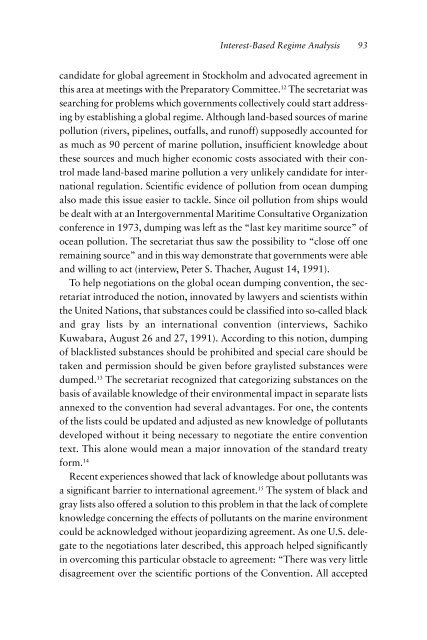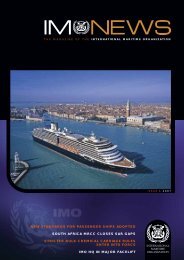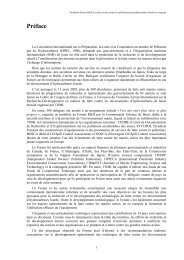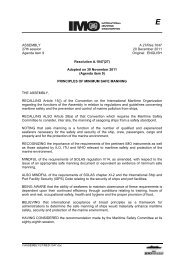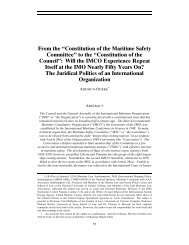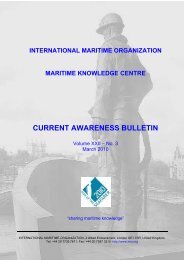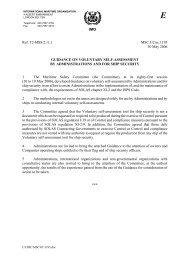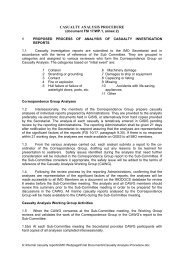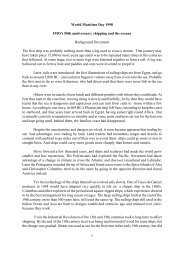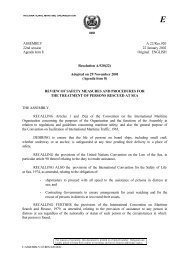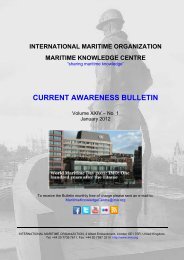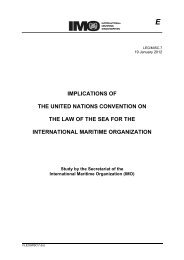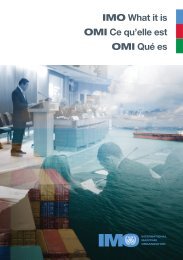Radioactive Waste Disposal at Sea: Public Ideas ... - IMO
Radioactive Waste Disposal at Sea: Public Ideas ... - IMO
Radioactive Waste Disposal at Sea: Public Ideas ... - IMO
You also want an ePaper? Increase the reach of your titles
YUMPU automatically turns print PDFs into web optimized ePapers that Google loves.
Interest-Based Regime Analysis 93<br />
candid<strong>at</strong>e for global agreement in Stockholm and advoc<strong>at</strong>ed agreement in<br />
this area <strong>at</strong> meetings with the Prepar<strong>at</strong>ory Committee. 12 The secretari<strong>at</strong> was<br />
searching for problems which governments collectively could start addressing<br />
by establishing a global regime. Although land-based sources of marine<br />
pollution (rivers, pipelines, outfalls, and runoff) supposedly accounted for<br />
as much as 90 percent of marine pollution, insufficient knowledge about<br />
these sources and much higher economic costs associ<strong>at</strong>ed with their control<br />
made land-based marine pollution a very unlikely candid<strong>at</strong>e for intern<strong>at</strong>ional<br />
regul<strong>at</strong>ion. Scientific evidence of pollution from ocean dumping<br />
also made this issue easier to tackle. Since oil pollution from ships would<br />
be dealt with <strong>at</strong> an Intergovernmental Maritime Consult<strong>at</strong>ive Organiz<strong>at</strong>ion<br />
conference in 1973, dumping was left as the “last key maritime source” of<br />
ocean pollution. The secretari<strong>at</strong> thus saw the possibility to “close off one<br />
remaining source” and in this way demonstr<strong>at</strong>e th<strong>at</strong> governments were able<br />
and willing to act (interview, Peter S. Thacher, August 14, 1991).<br />
To help negoti<strong>at</strong>ions on the global ocean dumping convention, the secretari<strong>at</strong><br />
introduced the notion, innov<strong>at</strong>ed by lawyers and scientists within<br />
the United N<strong>at</strong>ions, th<strong>at</strong> substances could be classified into so-called black<br />
and gray lists by an intern<strong>at</strong>ional convention (interviews, Sachiko<br />
Kuwabara, August 26 and 27, 1991). According to this notion, dumping<br />
of blacklisted substances should be prohibited and special care should be<br />
taken and permission should be given before graylisted substances were<br />
dumped. 13 The secretari<strong>at</strong> recognized th<strong>at</strong> c<strong>at</strong>egorizing substances on the<br />
basis of available knowledge of their environmental impact in separ<strong>at</strong>e lists<br />
annexed to the convention had several advantages. For one, the contents<br />
of the lists could be upd<strong>at</strong>ed and adjusted as new knowledge of pollutants<br />
developed without it being necessary to negoti<strong>at</strong>e the entire convention<br />
text. This alone would mean a major innov<strong>at</strong>ion of the standard tre<strong>at</strong>y<br />
form. 14<br />
Recent experiences showed th<strong>at</strong> lack of knowledge about pollutants was<br />
a significant barrier to intern<strong>at</strong>ional agreement. 15 The system of black and<br />
gray lists also offered a solution to this problem in th<strong>at</strong> the lack of complete<br />
knowledge concerning the effects of pollutants on the marine environment<br />
could be acknowledged without jeopardizing agreement. As one U.S. deleg<strong>at</strong>e<br />
to the negoti<strong>at</strong>ions l<strong>at</strong>er described, this approach helped significantly<br />
in overcoming this particular obstacle to agreement: “There was very little<br />
disagreement over the scientific portions of the Convention. All accepted


